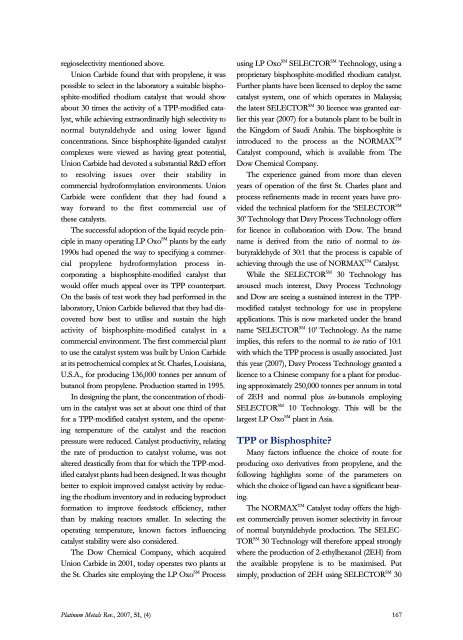Enhancement of Industrial Hydroformylation Processes by the ...
Enhancement of Industrial Hydroformylation Processes by the ...
Enhancement of Industrial Hydroformylation Processes by the ...
Create successful ePaper yourself
Turn your PDF publications into a flip-book with our unique Google optimized e-Paper software.
egioselectivity mentioned above.<br />
Union Carbide found that with propylene, it was<br />
possible to select in <strong>the</strong> laboratory a suitable bisphosphite-modified<br />
rhodium catalyst that would show<br />
about 30 times <strong>the</strong> activity <strong>of</strong> a TPP-modified catalyst,<br />
while achieving extraordinarily high selectivity to<br />
normal butyraldehyde and using lower ligand<br />
concentrations. Since bisphosphite-liganded catalyst<br />
complexes were viewed as having great potential,<br />
Union Carbide had devoted a substantial R&D effort<br />
to resolving issues over <strong>the</strong>ir stability in<br />
commercial hydr<strong>of</strong>ormylation environments. Union<br />
Carbide were confident that <strong>the</strong>y had found a<br />
way forward to <strong>the</strong> first commercial use <strong>of</strong><br />
<strong>the</strong>se catalysts.<br />
The successful adoption <strong>of</strong> <strong>the</strong> liquid recycle principle<br />
in many operating LP Oxo SM plants <strong>by</strong> <strong>the</strong> early<br />
1990s had opened <strong>the</strong> way to specifying a commercial<br />
propylene hydr<strong>of</strong>ormylation process incorporating<br />
a bisphosphite-modified catalyst that<br />
would <strong>of</strong>fer much appeal over its TPP counterpart.<br />
On <strong>the</strong> basis <strong>of</strong> test work <strong>the</strong>y had performed in <strong>the</strong><br />
laboratory, Union Carbide believed that <strong>the</strong>y had discovered<br />
how best to utilise and sustain <strong>the</strong> high<br />
activity <strong>of</strong> bisphosphite-modified catalyst in a<br />
commercial environment. The first commercial plant<br />
to use <strong>the</strong> catalyst system was built <strong>by</strong> Union Carbide<br />
at its petrochemical complex at St. Charles, Louisiana,<br />
U.S.A., for producing 136,000 tonnes per annum <strong>of</strong><br />
butanol from propylene. Production started in 1995.<br />
In designing <strong>the</strong> plant, <strong>the</strong> concentration <strong>of</strong> rhodium<br />
in <strong>the</strong> catalyst was set at about one third <strong>of</strong> that<br />
for a TPP-modified catalyst system, and <strong>the</strong> operating<br />
temperature <strong>of</strong> <strong>the</strong> catalyst and <strong>the</strong> reaction<br />
pressure were reduced. Catalyst productivity, relating<br />
<strong>the</strong> rate <strong>of</strong> production to catalyst volume, was not<br />
altered drastically from that for which <strong>the</strong> TPP-modified<br />
catalyst plants had been designed. It was thought<br />
better to exploit improved catalyst activity <strong>by</strong> reducing<br />
<strong>the</strong> rhodium inventory and in reducing <strong>by</strong>product<br />
formation to improve feedstock efficiency, ra<strong>the</strong>r<br />
than <strong>by</strong> making reactors smaller. In selecting <strong>the</strong><br />
operating temperature, known factors influencing<br />
catalyst stability were also considered.<br />
The Dow Chemical Company, which acquired<br />
Union Carbide in 2001, today operates two plants at<br />
<strong>the</strong> St. Charles site employing <strong>the</strong> LP Oxo SM Process<br />
using LP Oxo SM SELECTOR SM Technology, using a<br />
proprietary bisphosphite-modified rhodium catalyst.<br />
Fur<strong>the</strong>r plants have been licensed to deploy <strong>the</strong> same<br />
catalyst system, one <strong>of</strong> which operates in Malaysia;<br />
<strong>the</strong> latest SELECTOR SM 30 licence was granted earlier<br />
this year (2007) for a butanols plant to be built in<br />
<strong>the</strong> Kingdom <strong>of</strong> Saudi Arabia. The bisphosphite is<br />
introduced to <strong>the</strong> process as <strong>the</strong> NORMAX TM<br />
Catalyst compound, which is available from The<br />
Dow Chemical Company.<br />
The experience gained from more than eleven<br />
years <strong>of</strong> operation <strong>of</strong> <strong>the</strong> first St. Charles plant and<br />
process refinements made in recent years have provided<br />
<strong>the</strong> technical platform for <strong>the</strong> ‘SELECTOR SM<br />
30’ Technology that Davy Process Technology <strong>of</strong>fers<br />
for licence in collaboration with Dow. The brand<br />
name is derived from <strong>the</strong> ratio <strong>of</strong> normal to isobutyraldehyde<br />
<strong>of</strong> 30:1 that <strong>the</strong> process is capable <strong>of</strong><br />
achieving through <strong>the</strong> use <strong>of</strong> NORMAX TM Catalyst.<br />
While <strong>the</strong> SELECTOR SM 30 Technology has<br />
aroused much interest, Davy Process Technology<br />
and Dow are seeing a sustained interest in <strong>the</strong> TPPmodified<br />
catalyst technology for use in propylene<br />
applications. This is now marketed under <strong>the</strong> brand<br />
name ‘SELECTOR SM 10’ Technology. As <strong>the</strong> name<br />
implies, this refers to <strong>the</strong> normal to iso ratio <strong>of</strong> 10:1<br />
with which <strong>the</strong> TPP process is usually associated. Just<br />
this year (2007), Davy Process Technology granted a<br />
licence to a Chinese company for a plant for producing<br />
approximately 250,000 tonnes per annum in total<br />
<strong>of</strong> 2EH and normal plus iso-butanols employing<br />
SELECTOR SM 10 Technology. This will be <strong>the</strong><br />
largest LP Oxo SM plant in Asia.<br />
TPP or Bisphosphite?<br />
Many factors influence <strong>the</strong> choice <strong>of</strong> route for<br />
producing oxo derivatives from propylene, and <strong>the</strong><br />
following highlights some <strong>of</strong> <strong>the</strong> parameters on<br />
which <strong>the</strong> choice <strong>of</strong> ligand can have a significant bearing.<br />
The NORMAX TM Catalyst today <strong>of</strong>fers <strong>the</strong> highest<br />
commercially proven isomer selectivity in favour<br />
<strong>of</strong> normal butyraldehyde production. The SELEC-<br />
TOR SM 30 Technology will <strong>the</strong>refore appeal strongly<br />
where <strong>the</strong> production <strong>of</strong> 2-ethylhexanol (2EH) from<br />
<strong>the</strong> available propylene is to be maximised. Put<br />
simply, production <strong>of</strong> 2EH using SELECTOR SM 30<br />
Platinum Metals Rev., 2007, 51, (4) 167
















